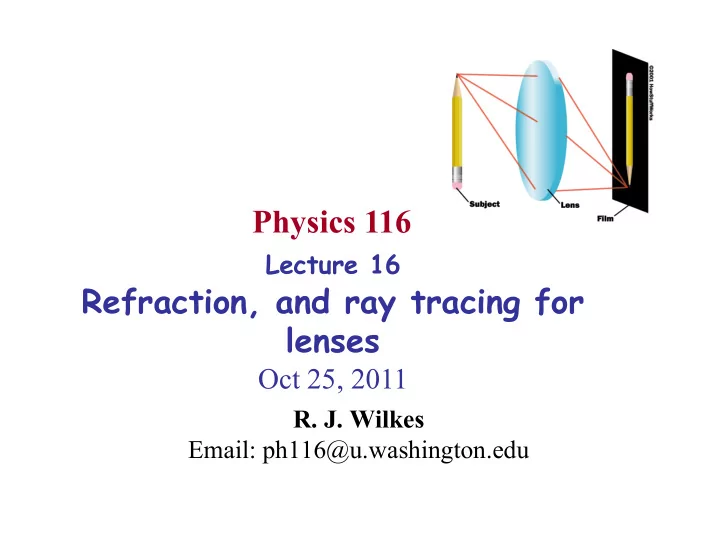

Physics 116 Lecture 16 Refraction, and ray tracing for lenses Oct 25, 2011 R. J. Wilkes Email: ph116@u.washington.edu
Announcements • � Guest lecturer today: Prof. Victor Polinger
Lecture Schedule (up to exam 2) Today 3
Mirror equation • � Euclid tells us how to find the relations between image, object and mirror locations for reflection, using the law of reflection, and ray tracing rules: it’s all about similar triangles Works for convex mirrors also: Just remember, R is negative for them: f = – R/2 4
Rules for using mirror equation • � Mirror equation lets us relate object distance, image distance, magnification, and focal length (or R) for spherical mirrors, both concave and convex • � BUT: to get all the signs right, we have to keep in mind the following rules when using the mirror equation f is positive for concave mirrors, negative for convex mirrors d I is positive if the image is in front of the mirror, negative if behind the mirror d O is positive if the image is in front of the mirror, negative if behind the mirror m is positive for erect images (same orientation as object), negative for inverted 5
Examples • � Object is placed 1.5R in front of concave mirror: what is image type, location, and magnification? Minus means inverted; rays converge at image, so it is real • � Object is placed 1.5R in front of convex mirror: what is image type, location, and magnification? Plus sign means erect image; rays appear to emerge from image, so it is virtual 6
Refraction • � Speed of light depends on “medium” – � No actual medium (no luminiferous ether), but atoms get in the way, slow down effective speed of light travel – � Universal constant c = 3x10 8 m/s = speed of light in vacuum • � Speed of light in any material medium is slower: c’ < c • � In typical glass c’ = (2/3)c, pure water = (3/4)c, air =0.9997c • � Index of refraction: n = c/c’, or c’=c/n (n >1.0, so c’ < c) – � so n glass = 3/2, n water = 4/3, n air = 1.0003 – � If light arrives at surface of a different material at an angle , it gets refracted (ray direction gets bent) ( Vertical ray is • � Law of refraction (Snell’s Law): ! 1 not bent) n 1 sin ! 1 = n 2 sin ! 2 n 1 For small angles, this is n 1 ! 1 = n 2 ! 2 n 2 or ! 2 ! 1 / ! 2 = n 2 / n 1 7
Parade analogy for refraction • � Imagine soldiers lined up in ranks, marching at constant speed • � Sgt. Bilko orders them to slow down to 2/3 normal speed when they cross a line marked on the parade ground – � But they mustn’t break ranks! Ranks of soldiers (Wavefronts) v Slowdown line (2/3)v 8
Parade analogy • � Here is a picture after part of the parade has passed the line Ranks of soldiers (Wavefronts) v Slowdown line (2/3)v – � Notice: • � if parade had approached at a right angle ( v perpendicular to the line), there would be no change of direction, ranks would just get closer • � This analogy works whether you believe in waves (ranks as a unit) or particles (individual soldiers): Newton and Young agree 9
Simple case: Refraction at a plane surface • � Light bends at interface between refractive indices – � bends more the larger the difference in refractive index – � can be effectively viewed as a “least time” behavior • � get from A to B faster if you spend less time in the slow medium – � Object at B appears to be at location B’ • � Fish in tank appears to be displaced • � Put your feet in the lake and they seem bent A Exact formula: n 1 sin � 1 = n 2 sin � 2 � 1 n 1 = 1.0 n 2 = 1.5 � 2 B’ B 10
Recommend
More recommend